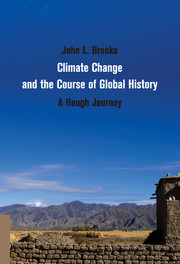Book contents
- Frontmatter
- Dedication
- Contents
- List of Figures and Tables
- Acknowledgments
- List of Abbreviations
- Introduction
- Part I Evolution and Earth Systems
- Part II Domestication, Agriculture, and the Rise of the State
- Part III Ancient and Medieval Agrarian Societies
- Part IV Into the Modern Condition
- Data Bibliography: Full Citations for Data Used in Figures and Tables
- Index
- References
Introduction
Growth, Punctuation, and Human Well-Being
Published online by Cambridge University Press: 05 August 2014
- Frontmatter
- Dedication
- Contents
- List of Figures and Tables
- Acknowledgments
- List of Abbreviations
- Introduction
- Part I Evolution and Earth Systems
- Part II Domestication, Agriculture, and the Rise of the State
- Part III Ancient and Medieval Agrarian Societies
- Part IV Into the Modern Condition
- Data Bibliography: Full Citations for Data Used in Figures and Tables
- Index
- References
Summary
This book is a venture into history on a grand scale, a contribution to what is coming to be known variously as “big history,” “deep history,” and “evolutionary history.” I begin with a foundational question: How has the history of the earth system shaped the history of the human condition? The most cursory consideration of these histories suggests the basic outline of the story. Over the very long term, the history of a volatile and changing earth has driven biological and human evolution: it has been a rough journey, and we are products of that journey. During long epochs of organic hunter-gatherer systems and agrarian economies, humanity was fundamentally subject to natural forces of an evolving earth system; our sudden transition into fossil-fueled industrial modernity has made us an increasingly active and determining agent in that earth system. Occasionally, too, hurricanes, earthquakes, or volcanic eruptions remind us that the earth is a very volatile platform for our finely balanced societies and economies.
This book, then, explores the role of nature – more precisely natural history – in human history. Doing so challenges a fundamental if rarely spoken tenet of my profession. We historians are extremely uncomfortable with the idea that natural forces in some way circumscribe human agency. Fearful of being labeled “environmental determinists,” we opt for a model of change in which all of the significant causal agents in historical processes are internal – or endogenous – to human culture, society, and economy. Given that most historians work on the past three to four centuries at most, this is not a completely unreasonable posture, because natural systems typically operate over much longer time frames.
- Type
- Chapter
- Information
- Climate Change and the Course of Global HistoryA Rough Journey, pp. 1 - 14Publisher: Cambridge University PressPrint publication year: 2014



